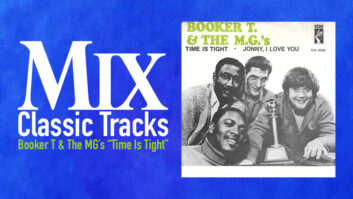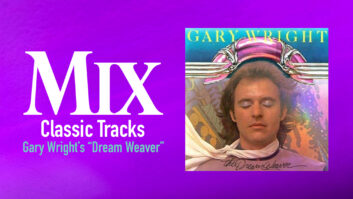
Read more “Classic Tracks”
Buy the book
The Four Seasons were part of America’s last Caucasian bulwark against the British invasion of the early 1960s. The group, who formed on the streets of Newark, N.J., in 1961, epitomized the doo-wop harmony sound and street attitude of the duck-tailed ’50s, but they also blended in R&B vocal influences that kept the sound and the attitude fresh. From 1961 through 1967 – the year the Beatles changed music forever with Sgt. Pepper’s – The Four Seasons made the Top 10 13 times, with hits including “Sherry,” “Big Girls Don’t Cry,” “Dawn” and “Let’s Hang On.” These came after nearly a decade in which the members of the group – lead vocalist Frankie Valli, whose piercing falsetto was the group’s trademark; keyboardist and vocal arranger Bob Gaudio; guitarist Tommy DeVito; and Nick Massi on bass – had kicked around the music business, collectively and individually. Valli had formed a nascent version of The Four Seasons, called The Four Lovers, which included DeVito, in 1956; Gaudio was a member of the Royal Teens, along with Al Kooper, and had penned the group’s biggest hit, “Short Shorts.” As The Four Seasons, they filled in small-time club appearances with studio work as background singers in the Manhattan studio scene.
But it was when the group connected with producer Bob Crewe that all four cylinders began to fire. Starting with “Sherry,” in 1962, The Four Seasons began a string of radio hits for the Vee-Jay label, until litigation kept the group out of the studio for almost a year before they were able to resurface on Philips Records, and “Dawn” put them back on the hit track. So, “Rag Doll” would be an important record for The Four Seasons – it was the follow-up to their first hit in a year. But the record, which would go on to spend 10 weeks in the Number One position on Billboard’s music charts, was anything but a major production. In fact, for a record that performed so well on the charts, it was completed very quickly – in a single session, in a single day.
“It was such a helter-skelter session,” recalls Bob Gaudio, the group’s main songwriter, vocal arranger and, later, its co-producer with Bob Crewe. “It was a Sunday and we were leaving town the next day for a lengthy tour. We couldn’t get into any of the usual studios we used in Manhattan, or get any of the engineers we usually worked with.” Those included Atlantic Studios and Olmstead Sound, and engineer Tom Dowd, who had engineered “Dawn.”
Scrambling to find a studio, the group located Allegro Sound, a 4-track demo studio at 1650 Broadway, on the ground floor of a midtown West Side hotel, not an unusual location for a studio in Manhattan in those days, when many studios of the previous two decades had used hotel ballrooms as tracking rooms. The group was also able to pull a favor from engineer Lenny Stei, who owned Stei-Philips Studios, where the group had recorded before. “It wasn’t our first choice of studio, especially since we had already moved to 8-track recording with `Dawn,'” Gaudio says. “And Lenny was more of a studio owner than an engineer and not our first choice – or even our twentieth choice – as an engineer, as I’m sure he would agree. It was really a favor on a Sunday morning, and we were getting desperate.”
Gaudio had written “Rag Doll” not long before this session: “I was driving into [Manhattan] for a session and I got stopped at Eleventh Avenue, which back then seemed like the longest traffic light in the world; like three minutes long,” he recalls. “If you got stopped there, you’d have these homeless people come up and try to wash your windshield for spare change. I saw this hand come up to my windshield and connected to it was a woman whose clothes were all tattered and who had this dirty face, like something out of Oliver [the Broadway show based on Dickens’ Oliver Twist]. I didn’t have any change on me. All I had was a ten-dollar bill, so I gave it to her. I drove off and saw her in the rearview mirror just staring at it. That image stayed with me. Within the next day, I had the chorus and the first verse. I couldn’t finish it, so I called in Bob Crewe to help and we had it done two weeks later.”
Convinced that “Rag Doll” was a smash hit and necessary to maintain the head of steam that “Dawn” had created, The Four Seasons and Crewe wanted to get it on tape before their tour began, prodded further by Philips Records’ desire to put out another song in its stead. Gaudio, DeVito and Massi, along with session drummer Buddy Saltzman, set up to play the basic track. Allegro had a small studio room, but it had what sounded like a huge live echo chamber, which would become part of the record’s sound.
“The overtones of that chamber were unbelievable,” Gaudio recalls. “We were concerned that it would be a bit too extreme, soundwise, especially if we also used it for the vocals. We really thought we were on thin ice. But we were stuck with that and the 4-track.”
What they also had were a bunch of rented percussion instruments lying around, left over from the previous week’s sessions, and not slated to be picked up until Monday. Gaudio and Crewe chose an African hair drum that happened to be there, and Saltzman, who was set up in the middle of the room with the rest of the band, played it along with a rack tom to create the opening bars of the song and the rhythm tattoo that carried the choruses. An open tambourine was also placed on the snare drum, which enhanced the fourth beat of the chorus measures, creating a sharp smash, which was in contrast with the tom/hair drum combination’s lower tones.
“The overtones of the tom and hair drum were very pronounced,” says Gaudio. “And the damn echo was slapping everything around. But it’s interesting that we noticed it mainly in retrospect. The media of the time – like AM radio – simply couldn’t reproduce it, so you didn’t hear it over the radio. The same with the monitors of the time, especially in a demo studio. You play the CD now and you think, that’s not what I heard back then.”
The track was laid down without a guide vocal. The group had learned and rehearsed it around a piano before the session. It is a very Spartan track; aside from the drums and percussion, only the bass, a bit of DeVito’s Fender electric guitar, and a counterpoint melody, played by Gaudio on a Farfisa organ, peek through the wall of echo-laden vocals. “We might have orchestrated it a bit more if we had the time,” Gaudio says. “But once the vocals were on, we could see it wasn’t needed.”
The background vocals went on first, with Valli singing as part of the four-part ensemble arrangement that Gaudio had come up with, typically Four Seasons, with the top and bottom notes the same. It was an approach used by The Four Freshmen, a group that Gaudio admired and emulated early in his career. Background vocals were double-tracked, with each vocal track and the basic allocated to a single track of the Scully 4-track deck, and then bounced down later to allow for overdubs, such as the upbeat Gospelesque handclaps that appear only on the rideout, another tambourine part, and Valli’s lead vocal. All the vocals were recorded with a Neumann U47 microphone, Crewe recalls. The Four Seasons arranged themselves around a single microphone, much the same way they had around streetlights in Newark, and usually only with half the headphones on. “We were very into balancing ourselves,” Gaudio explains.
“There was a lot of generational loss on that record, because it was 4-track and we had to bounce,” Gaudio notes. “But again, radio forgave a lot of that. And while we were sensitive to that, and often relied on mastering to fix it, ultimately we were always into the feel of the record. That always came first.”
The tracking and vocals took the better part of the day. But thanks to the track-bouncing during the session – and the fact there were only four tracks – the mix was fast and easy. “We were definitely committed on the drum sound, including the echo chamber,” says Gaudio. “Fortunately, the echo fit in nicely with the same chamber on the vocals. It wasn’t swimming in reverb, which was the original concern. All the track needed – and all we could do, anyway – was add a little bit of EQ here and there and a little extra echo.”
Like many recordings from that era and before, CD versions and FM radio reveal all sorts of anomalies on the tracks. You can hear the bangles of the tambourine being moved away from the microphone in between verse and chorus, and there’s one spot where the tine sound is slightly out of time and sounds like it was accidentally hit. Recordings like “Rag Doll” were never intended for this kind of microscopic scrutiny, but Gaudio says it wasn’t an issue then or now. “It really became part of the sound,” he says. “It created a sound that was fresh and worked on radio.”
The hurried nature of the making of “Rag Doll” didn’t end with the session that Sunday night. Gaudio remembers that it was rushed to mastering and was on the radio within 10 days of the session. But The Four Seasons were old hands at doing things quickly. “We once did an entire Christmas album in 28 hours,” Gaudio says proudly. “And right after that we did five shows at the Apollo. Now that’s fast.”







